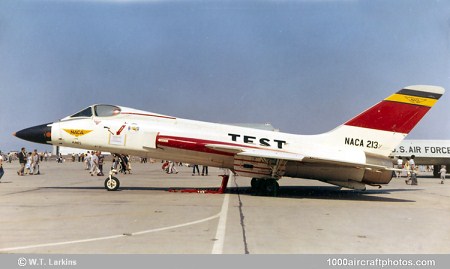Designated F4D-2N when two prototypes (BuNos. 139208 c/n 11282 and 139209 c/n 11283) of the carrier-borne interceptor were ordered, the aircraft was initially conceived as a progressive development of the F4D-1. However, as engineering design progressed it became necessary to depart substantially from this concept and, to reflect this change, the new type was re-designated F5D-1 and named Skylancer. Retaining the wing planform of the F4D-1 the F5D-1 had wings of much reduced thickness/chord ratio and a longer fuselage housing additional fuel tanks bringing total internal fuel capacity up from the 640 gal (2,423 l) in the F4D-1 to 1,333 gal (5,408 l).
While, initially at least, the four wing-mounted 0.787 in (20 mm) cannon were to have been retained, armament was revised and was to have primarily consisted of four Sidewinder or two Sparrow air-to-air guided missiles and/or spin-stabilized unguided 2.0 in (51 mm) rockets. Other changes included a redesign of the air intakes, the use of a two-piece, V-shaped, forward canopy, and a taller fin and rudder. In this form, and powered by a 10,200 lb (4,627 kg) st – 16,000 lb (7,257 kg) with afterburner – Pratt & Whitney J57-P-8 turbojet, the first F5D-1 made its maiden flight at Edwards AFB, on 21 April, 1956.
By that time nine Service evaluation machines (BuNos. 142349 to 142357) and 51 production F5D-1s (BuNos. 143393 to 143400, and 145159 to 145201) had already been ordered and it was planned that initial production aircraft would be powered by a 10,700 lb (4,853 kg) st – 16,900 lb (7,666 kg) with afterburner – Pratt & Whitney J57-P-14 and later production aircraft would have the still more powerful General Electric J79 (to test this proposed turbojet installation the second XF4D-1 was fitted with a J79 engine).
However, although the two J57-P-8 powered prototypes and the similarly-powered first and second Service trial F5D-1s (BuNos. 142349 c/n 11592 and 142350 c/n 11593) performed satisfactorily during their flight trial program, the decision was made to suspend production as the F5D-1's performance was similar to that of the Chance Vought F8U-1 which had entered service with VF-32 in March 1957.
After the decision not to proceed with the Skylancer, the F5D-1s were used at Edwards AFB as flying test beds for radar systems, instruments and armament. Later all four aircraft were transferred to the Ames Laboratory of NACA (became NASA on October 1, 1958) at Moffett Field, California. BuNos. 139208 and 142350 were handed over on August 20, 1957 and used for experiments, while BuNos. 139209 and 142349 were handed over in June 1958, these were used for spare parts.
BuNo. 139208 received the tail code NACA "212" (later NASA "212", then NASA "708") and was fitted with wings of modified ogee planform to study leading edge vortices, as part of NASA research in support of the US supersonic transport program, it was retired in April 1968. BuNo. 142350 received the tail code NACA "213" (later NASA "213", then NASA "802") and became a target for auto maneuver interception, was used for Dyna-Soar pad escape tests, and eventually became a chase plane. In 1970 it was retired to the Air Force Museum, and in 1972 was transferred to the Armstrong Air & Space Museum at Wapakoneta, Ohio.
